What do the plastic numbers mean?
You may have noticed numbers like this with a triangle on the bottom of plastic containers and bottles.
Being a waste educator, I’m often asked “What do these recycling numbers mean?” People sometimes misinterpret it, and ask “which plastic numbers get recycled?”
The short answer is, the plastic number symbols advise what type of plastic the item is. But the symbol doesn’t tell you if it will be recycled.
These plastic codes are often referred to as recycling symbols, which is confusing for consumers because the plastic coding symbols are there for the plastic recyclers to identify the plastic type. It was not intended to inform the consumer about recycling.
For a simply way to understand what can be recycled, it’s best to use the Australian recycling label (ARL) which explains if, and how or where, packaging can be recycled.
As for what the numbers mean here’s the low down. Use the clickable table of contents to jump to what you want to know.
How to understand recycling codes – video
What is the plastics number code for?
What do the plastic recycling number codes mean?
1 – Polyethylene Terephthalate (PET or PETE)
2 – High-Density Polyethylene (HDPE)
3 – Polyvinyl Chloride (PVC or V)
4 – Low-Density Polyethylene (LDPE)
What plastic can go into council recycling bins?
How to avoid single use plastic
How to understand recycling codes
Here’s a segment from the House of Wellness. They asked me to talk about recycling numbers. But if you’d rather read about it, you can scroll down.
Note: the below is not a transcript
What is the plastics number code for?
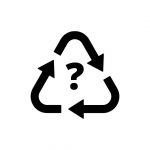
The plastic symbols are the Resin Identification Coding System (RICS). This plastic identification system was launched by the Society of the Plastics Industry in the US in 1988, who are now known as the Plastics Industry Association. According to Chemistry Australia, the use of the code was introduced into Australia in 1990.
While the RICS is meant for industry, it can be helpful for consumers who want to know more about the plastics they’re using.
But it’s important to know that while recyclers use these plastic codes, they’re not reliable to determine if the plastic will be recycled or not.
What do the plastic recycling number codes mean?
The plastic codes were developed for the waste industry so recyclers and plastic re-processors can visually identify plastics to sort if for recycling. Plastics have different melting temperatures and behave differently. And if the wrong plastic gets in, it can contaminate the batch.
So really all the number codes are is an identifier. But here’s what they mean
1 – Polyethylene Terephthalate (PET or PETE)
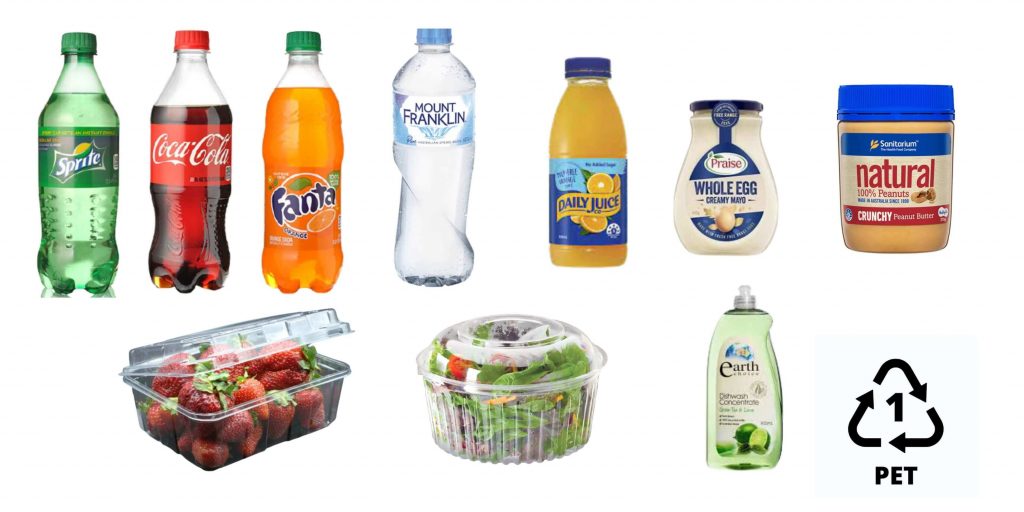
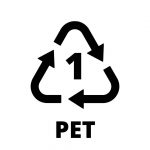
PET is clear, tough and solvent resistant. It can be coloured, but will still be transparent. This the most used plastic, it’s widely recycled but also very cheap as a virgin plastic.
You’ll find PET plastic in water bottles, soft drink and sport drink bottles, fruit juice bottles, clear condiment bottles, peanut butter jars, fruit punnets and clear plastic meat trays. Cleaning products in clear bottles will also be PET.
When PET is used as a fibre in textiles it is called polyester. It is used in clothing, pillow fillings and other items.
Clear PET bottles are recycled back into bottles, or even into polyester clothing. If you see rPET this means it’s made from recycled plastic.
2 – High-Density Polyethylene (HDPE)
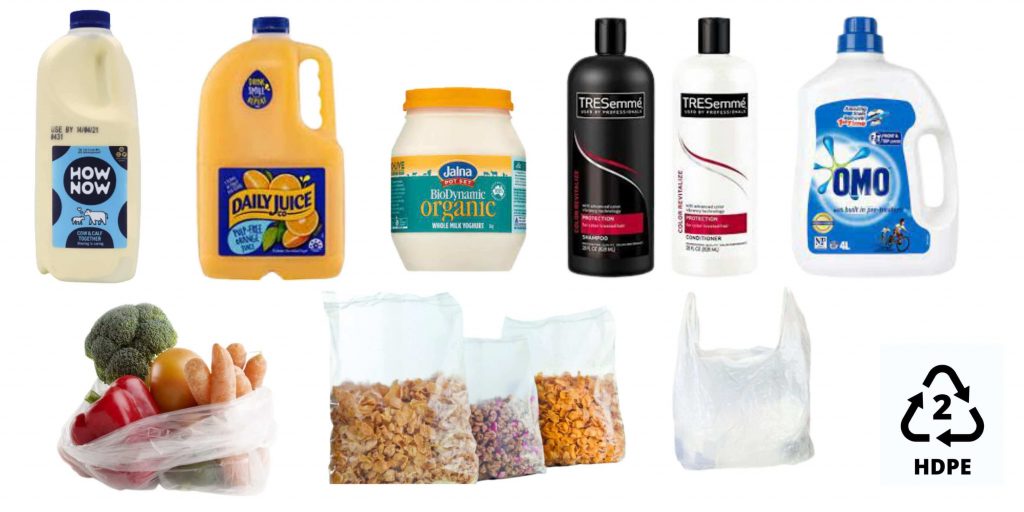
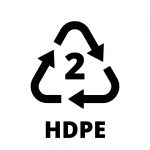
A versatile plastic, as HDPE comes in both hard and soft plastic forms. It is opaque or cloudy but can be white or sometimes coloured. Also is also used for bottle lids.
As a hard or rigid plastic, it is used in milk bottles, laundry and cleaning product bottles.
Milk bottles will be turned into products like piping or plastic pallets. Detergent bottles may be turned back into detergent bottles again.
When in soft plastic form, it is the crinkly plastics, which are typically freezer bags, shopping bags, cereal box liners, and other plastic food packaging. These soft plastics can be recycled by REDcycle when you drop them off in the bins at your local supermarket. They may be recycled back into thicker plastic bags or park benches.
3 – Polyvinyl Chloride (PVC or V)
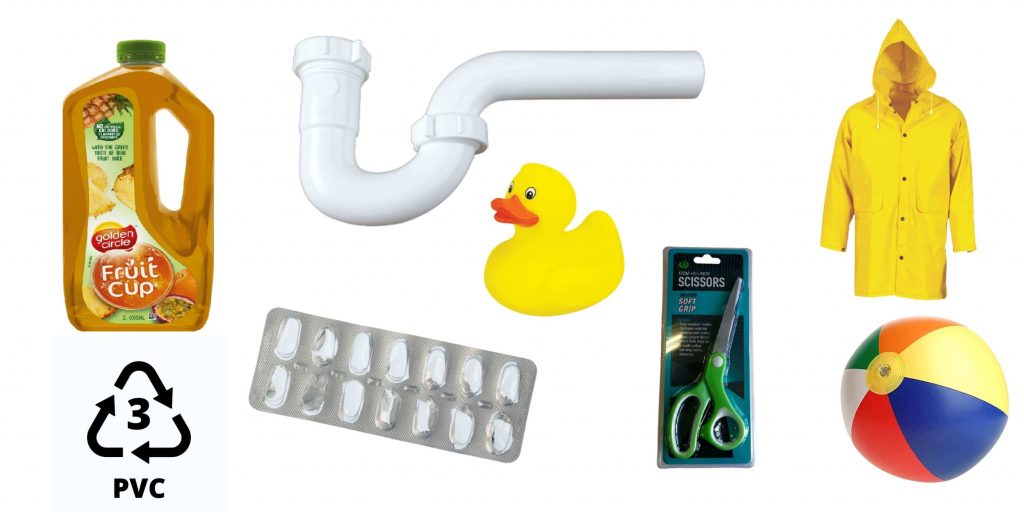
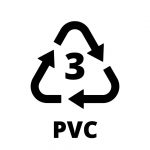
PVC is everywhere, it is a highly durable plastic and has a wide variety of applications. PVC is resilient to chemical and biological damage and it moulds well into shapes, so is very versatile. It is also use in both hard and soft plastic forms too.
It’s commonly used in building and construction for plumbing pipes, flooring, cladding, windows, roofing, fencing, decking, wallcoverings and electrical wiring.
In household packaging it is used in pharmaceutical blister packs and sometimes cordial bottles. It is also use in blister packaging – you know the type which scissors come in, but you need a pair of scissors to get into the scissors.
As well as in rain coats, gum boots, pool toys, vinyl mats and much more.
The complication with PVC is that it is similar in appearance to PET, and small amounts of PVC can contaminate a batch of PET when recycling. So PVC is being phased out of packaging
There are extended recycling programs for PVC pipes and other types of PVC, but it’s limited, is more difficult to recycle and can pose health risks during the recycling process due to the chlorine element in the plastic.
4 – Low-Density Polyethylene (LDPE)
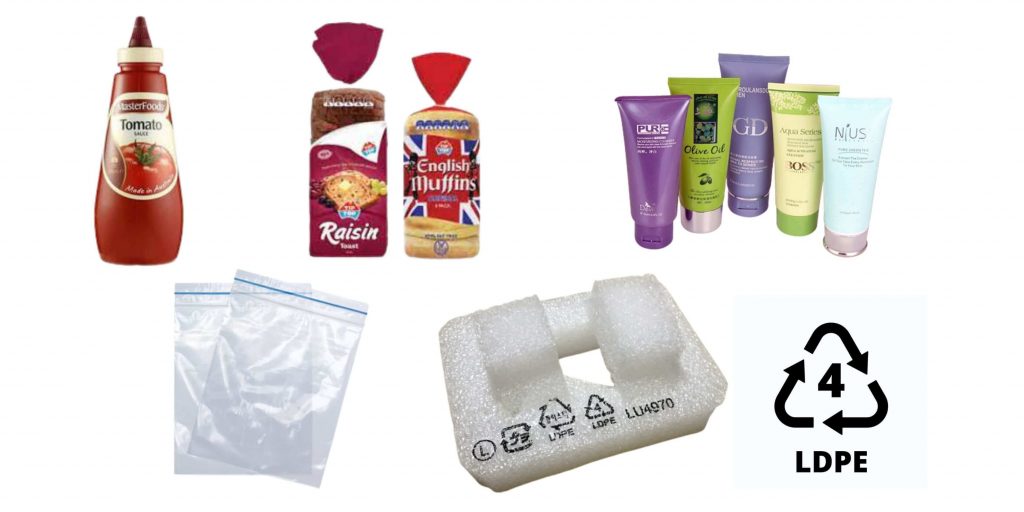
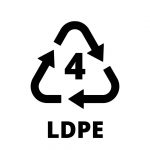
LDPE is a very flexible plastic, lightweight plastic which is puncture resistant. It is typically a soft plastic, but it is also used in squeeze bottles and tubes.
It is used for shopping carry bags, bread bags, produce bags, garbage bags, stretch and shrink films, in the soft plastic form. Plastic bags can be recycled via the RedCycle by dropping them off at supermarkets.
As a hard plastic it used for sauce bottles, black irrigation tubing, foam packaging and other moulded equipment. Which can be recycled via council kerbside collections.
5 – Polypropylene (PP)
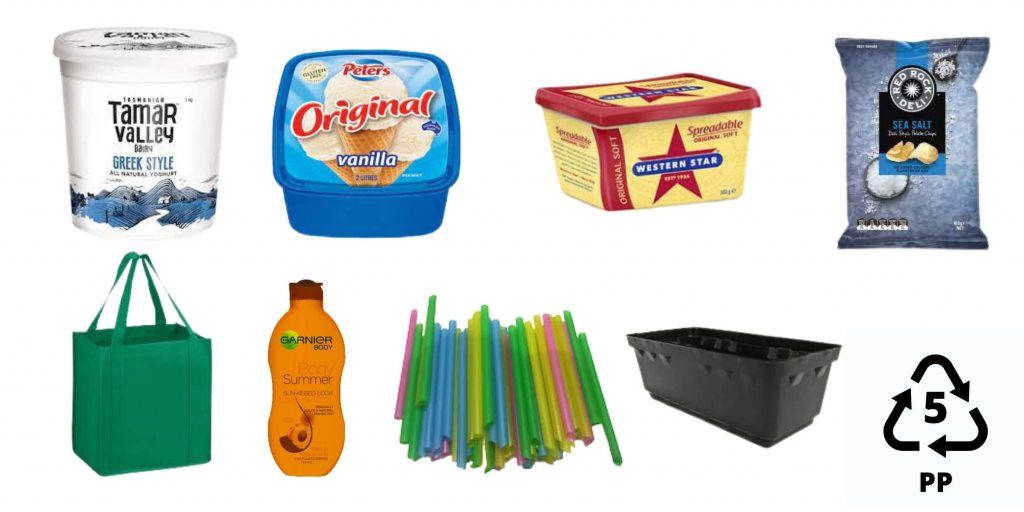
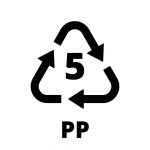
Polypropylene a hard but still flexible plastic. Often translucent, but can be transparent too. It has good chemical resistance.
It’s used for ice cream, yogurt, takeaway, butter and margarine containers.
Polypropylene may be turned back into the containers again
As a soft plastic polypropylene is used in chip packets, straws, cereal bags in boxes.
Other applications include plant pots, toys, carpet fibre, appliances, automotive, housewares, furniture and more.
Polypropylene as a textile is called polypro, it’s commonly used in warm weather, and protective clothing. It’s commonly used in woven plastic bags.
6 – Polystyrene (PS)
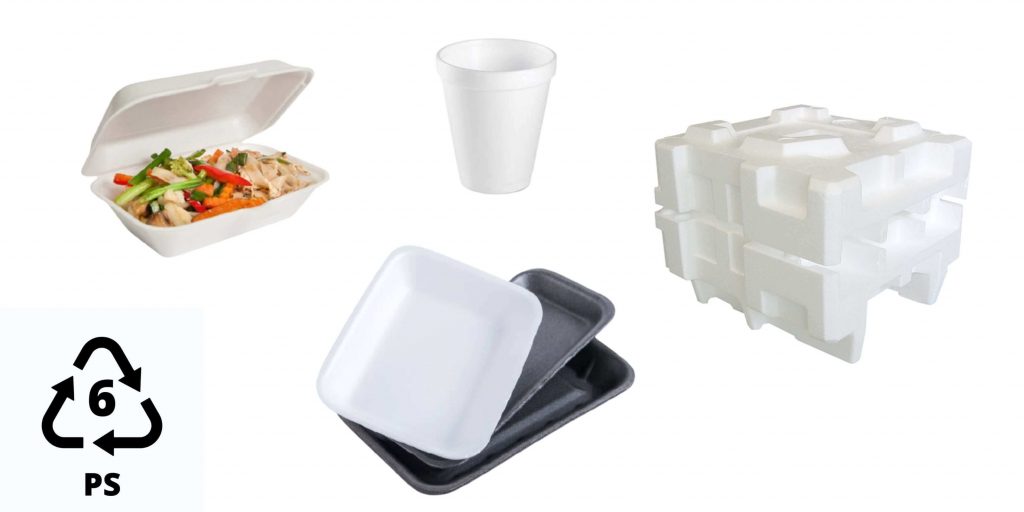
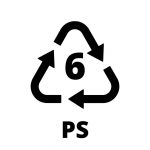
Polystyrene, is also known as Styrofoam or expanded polystyrene (EPS). It is very light, but bulky. It is used in cups, foam food trays and packing materials.
Polystyrene is recyclable, but it can’t be recycled in your council kerbside recycling bin. The trouble is that it’s so light and bulky, which adds the recycling carbon footprint when in this form. But when compressed it is easier and more viable to recycle.
There are recycling programs where you can drop clean polystyrene off. But it’s best to contact the drop off point, as there can be restrictions.
Polystyrene is being phased out of packaging. A great initiative is Planet Protector who have created a reusable woolpack from waste wool as an alternative option.
7 – Other plastics
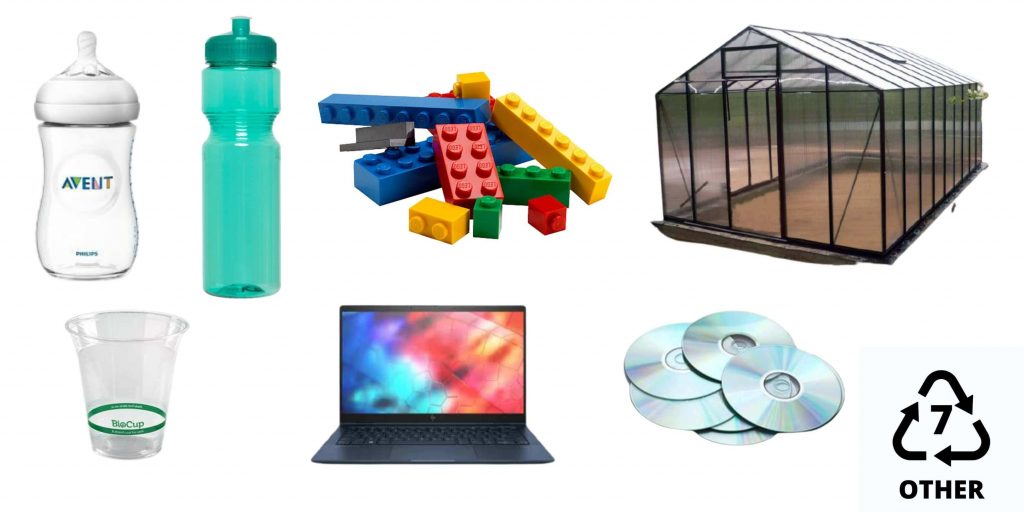
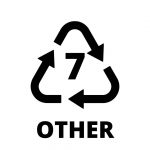
This covers a range of plastic types. Effectively all other plastics which aren’t listed such such as, acrylic, nylon, polyurethane, polycarbonates, bioplastics and any other type of plastic.
It doesn’t really tell us much about the plastic, except that it’s not one of the above.
Number 7 plastics aren’t accepted kerbside recycling. But you can look around for other extended recycling programs.
What plastic can go into council recycling bins?
The plastic which can be put in your kerbside or council recycling bin, is the hard plastic packaging.
It is safe to say
- Juice bottles
- Milk bottles
- Shampoo, conditioner, shower gel bottles
- Soft drink bottles
- Cleaning product bottles
- Detergent bottles
- Ice-cream containers
- Yogurt tubs
Soft plastics, cannot go into your council recycling. These plastics are classed as scrunchable, and don’t hold their shape. This includes all plastic bags, including carry bags, as well as cling wrap, food coverings and bubble wraps. This is because the recycling facilities are designed for hard plastics and they can’t manage soft plastics, which can clog the machinery. You can take this to the supermarket to be RedCycled.
Disclaimer: this can vary, and some councils accept additional plastics too. For the full list of what you can recycle, in your area, please refer to your local council. Most have really great resources or downloadable guides or apps which can tell you.
Yes, it is frustrating there isn’t a straight answer. But here are some state-wide resources which may help.
Note: If you this doesn’t give your answer then please message, email or call your council – there are sustainability waste officers in every council who want you to get this right. Their job is to help you with all your waste questions, and it helps for them to know what you’re unsure about.
Extended Recycling programs.
There are many things which can be recycled, even if they can’t go into your kerbside council collections.
There is more information from Recycling Near You
If you have any recycling questions, ask away and I’ll do my best to answer them.

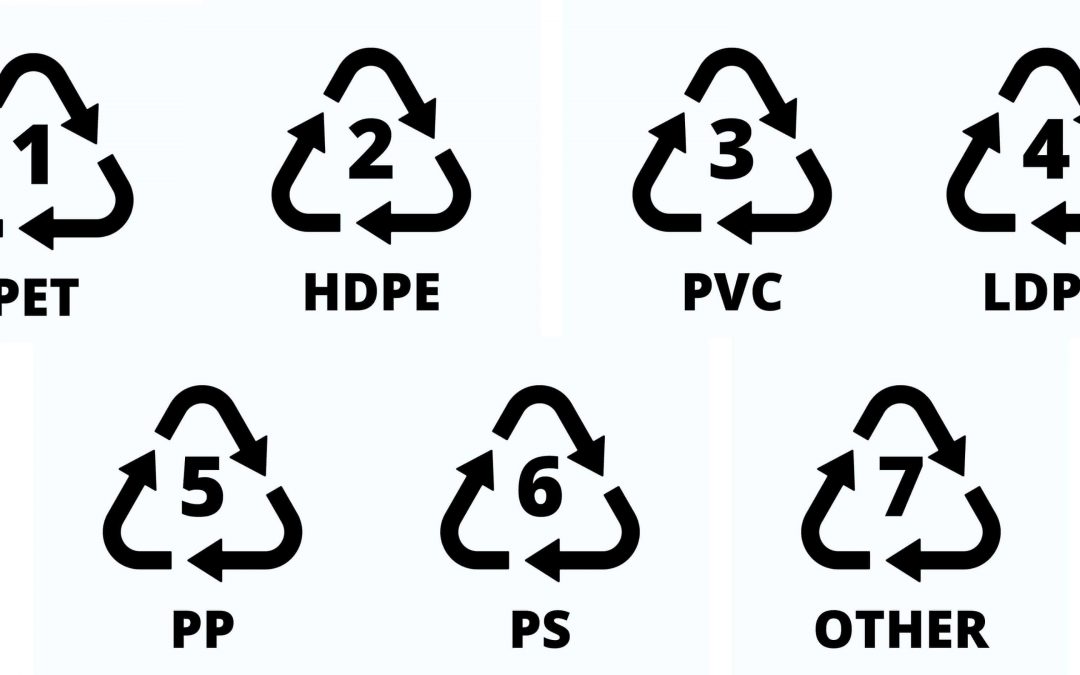

Hello there,
Today, after finding two HDPE plastic carry bags in my communal ,yellow lidded, recycling bin, I reviewed your website’s clear, coloured list of symbols on this page.
This page has been more helpful & authoratitive than any other of the online search results.
Well done! 🙂
Julie
Sydney, N.S.W.
A most wonderful in detail explanation.
It is time that you updated the site. There is no ‘redcycle’ and has not been for some time!
This page also has other outdated information.